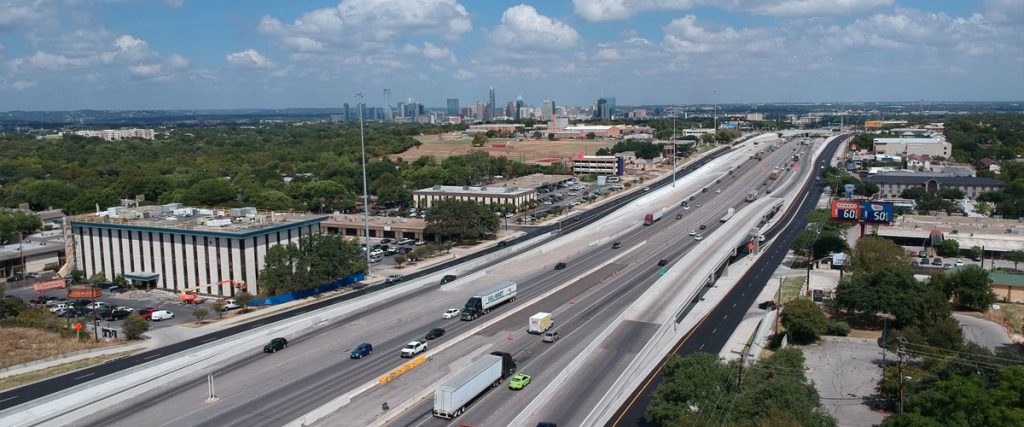Corridor Features
Proposed Improvements
The I-35 Capital Express Program proposes roadway elements, designs and features that will improve mobility and safety along the corridor. Explore the various proposed improvements below.

Diverging diamond interchanges
Diverging diamond interchanges (DDIs) use an innovative design to address congestion by allowing vehicles to travel more quickly through an intersection and increase safety by reducing the number of potential conflict points. The North project proposes a DDI on I-35 at Wells Branch Parkway. Learn more about DDIs.
High-occupancy vehicle lanes
High-occupancy vehicle (HOV) lanes, sometimes called carpool lanes, are a type of managed lane. HOV lanes are reserved for the use of carpools, vanpools, emergency services and transit vehicles. These lanes are typically located next to the general-purpose lanes and enable those who carpool or ride the bus to bypass traffic in the adjacent lanes. Lanes are identified as “2-plus” which refers to the minimum number of vehicle occupants to qualify.
Intersection bypass lanes
An intersection bypass lane is a dedicated lane for traffic exiting the mainlanes or traveling on the frontage road to bypass a signalized intersection. Intersection bypass lanes allow traffic to bypass frontage road traffic signals at cross streets and are separated from the mainlanes. Learn more about intersection bypass lanes.
Shared-use paths
Shared-use paths provide a paved, off-road travel area for non-motorized users, such as bicyclists, pedestrians, skaters, joggers and others.
Smart work zones
Intelligent transportation systems (ITS) can be used in highway work zones to help improve public safety and mobility. The resulting systems are commonly referred to as “smart work zones” because they leverage the information derived from the ITS equipment to improve operations within and around the work zones. Learn more about smart work zones.
Traffic management systems
Traffic Management Systems (TMS) use technology solutions to reduce congestion and improve safety during and after construction. TMS maximizes the use of the roads we have and, when paired with adding lane capacity, the state can maximize congestion reduction and investment value. Learn more about traffic management systems here.
Future proofing
With the continued growth and advancing technological needs of Central Texas communities, it is essential for roads and highways to be efficient and productive for the future. TxDOT is looking to design and implement “future-proofing” technologies that will increase safety, protect against extreme weather events, reduce life cycle costs, integrate connected and autonomous vehicles (CAV), optimize existing infrastructure and change the operations and capacity of infrastructure systems. Learn more about future proofing here.
Single-Point Urban Interchange
A single-point urban interchange (SPUI) is an intersection design that allows a large volume of vehicles to travel through the intersection safely and efficiently by reducing conflict points and the number of traffic signal phases. Similar to a diverging diamond interchange (DDI), the SPUI allows opposing left turns to proceed simultaneously. Unlike a DDI, streams of left-turning traffic in a SPUI are not shifted to the opposite side of the roadway. Opposing left turns can be made at the same time; with only one set of traffic signals, allowing more vehicles to clear the intersection in one traffic signal cycle.
Benefits of a SPUI include:
- Improved safety: With only one signalized intersection rather than two at a conventional diamond interchange, vehicles only cross paths at one location.
- Improved travel time: Additional “green time” at traffic signals allows more vehicles to pass through the intersection.
- Wider turns for large vehicles.
- Reduced right-of-way requirements.
A SPUI is being considered for the intersection of I-35 at SH 29. Watch the SPUI explanatory video to see how it works. You can also read the SPUI fact sheet to learn more.
Ongoing stakeholder involvement is necessary to identify and refine proposals for the corridor. Questions and comments are welcome at any time.
Contact Us

